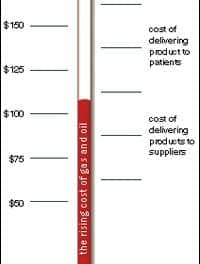A longtime PT shares the reasons he pursued and obtained a transitional Doctor of Physical Therapy (t-DPT) degree.
By Mike Studer, PT, DPT, MHS, NCS, CEEAA, CWT, CSST, FAPTA
Back to school, at 51 years old?
Something to prove?
Something to gain?
The answers, in order, are “yes,” “yes,” and “yes.”
I graduated in 1991 with a bachelor’s in physical therapy from the University of Missouri-Columbia. I treasured my experience there and left with a thirst for continued education that would seemingly never be fulfilled. I sought and achieved board certification in neurologic physical therapy in 1995, which was an excellent push in knowledge acquisition and application. Little did I know then that my thirst would next be quenched by going back to school for my “next” terminal degree—a Master’s of Health Science, graduating in 1998 from the University of Indianapolis.
In 2004, I opened my own outpatient neurologic-geriatric multidisciplinary clinic. This grew to become four locations with a location for each subspecialty: geriatrics/neurologic (2 locations), orthopedics, and performance. Seventeen years later, in 2021, then at age 51, why would I consider a t-DPT? What was there to gain, prove, and “why now”?
Perfect Timing for a t-DPT
My perception was that this was the “perfect timing” for a new stimulus. My wife and I sold our four-location and five-program clinic operation in November 2020. I was serving as a full-time clinician and the practice administrator for a 50+ employee operation, working on average 92 hours per week. With the sale, I negotiated a 35-hour/week full-time clinician position. So, my story of “why enroll in a DPT program now”…includes the concept of “re-entry,” considering the +/- 57 hours/week that I “should” have on my hands. Now became the perfect time to enroll, yes, per the first question above, at 51.
Listen to more from Mike Studer on this topic in our podcast episode “Getting a Transitional DPT Degree”
Something to Prove
As for the second question, “something to prove,” this might seem like an odd question to answer “yes” to. Does going back to school send a message that education is lifelong? Would re-investing in myself and my career model the importance of clinical fitness, to continue to serve my patients and peers (as a clinical educator) with the best version of myself?
In an online-only program, I found myself benefiting from a more diverse thought pool than I might have had were I attending a program in person, or even one that might be regionally more convenient for me to get to every 3 to 6 months. I was in class with some of the same people throughout the program, and some new with each pair of classes that I enrolled in, over the 11 months of my attendance. (Although I should note here that most often, it takes 2 years to complete the coursework for this degree). I was experiencing diversity in discussing health policy with persons from Singapore, the Philippines, and the United States. I was delivering and receiving commentary on my posts and projects from the same. Here in 2022, I should not need to elaborate on the value of being exposed to diverse perspectives. This was an unexpected gift that I will treasure for life.
Admittedly, I needed this pivot. I needed to re-prove to myself that I could master these areas of self-identified weakness. While many of us have a degree of imposter syndrome, I was faced in 2021 with a sensation of questioning my own mastery. My lifelong expectations of excellence had caused me to feel an increasing desire to fill these voids in specific knowledge sectors.
Something to Gain
Finally, the third question, “something to gain?”. This was an even more clear and compelling reason than having time on my hands. I enrolled in a transitional Doctor of Physical Therapy program (t-DPT) for a few distinct reasons: knowledge, stimulus, and degree, in that order. My expectations of the program were to help me resolve three main knowledge bases: pharmacology, differential diagnosis, and imaging.
I wanted and needed the education, moreso than the degree or initials. I had expectations of “earning and learning” for this degree. I wanted to work hard and learn clinically applicable material for my neurologic and geriatric practice. Many t-DPT programs were well suited to my expectations, and would allow me to work hard, challenge me, and afford me the opportunity to shape my clinical direction. Ultimately, I would only be earning a degree and not truly usable knowledge if I could not make it applicable to my area of practice. This was not only permitted, but welcomed in my program of choice, The College of St. Scholastica (CSS).
While the t-DPT CSS program allowed me to focus on geriatrics and neurology, I found the program inviting me in many ways to become more well-balanced and informed. Through assignments in each class of the program, I was exposed to the diverse thoughts of my classmates, writing about pelvic health, community wellness, orthopedics, and pediatrics. While it is true that I was given the full opportunity to stay focused, I now look back and see that having the autonomy to stay with familiar topics and themes afforded me the opportunity to begin writing about chronic pain, imaging, and community health at my own pace and as my comfort developed. This was refreshing and respectful, and left me feeling like a professional, rather than feeling burdened or wasteful of my time.
Expanding My Learning
Where does my career and acquisition of this degree intersect with Vision 2020? Broadly, I could offer that I will have met the expectations of a doctoring profession and a board-certified specialist. More specifically, I can say that as the knowledge base of movement science evolves, so should I. Additionally, this education positioned me to be a more effective autonomous practitioner.
While I have stated the broad and overarching benefits, I will close with a brief perspective on the details. Many t-DPT programs have a set of core and elective classes. Within my program of choice, I attended 6 classes at a rate of 2 classes per term over the course of 3 separate terms. I thought that I knew my shortcomings going into the program. However, my eyes were opened more widely, seeing what I did not know all-too-well just a few weeks into health policy and evidence-based practice (EBP). Suffice to say, I received much needed education in EBP, helping me to overcome an aversion to research, to the point that I went from being fearful to read beyond the abstract to being empowered to critique. Additionally, I learned valuable and clinically relevant skills, which I did not know that I could from a remote program. My knowledge base in diagnostic imaging, pharmacology, and differential screening had a long way to go. The knowledge received helps me to have an elevated base for my continued lifelong learning efforts. These classes additionally provided a foundation on which my capstone could culminate the application.
If you are considering a t-DPT, I hope that my experience can help you with the decision. Now 9 months since graduating, there has not been a day that’s gone by that I have not used my education either in the clinic, reading articles, or preparing for patient care. The process of being the best version of myself does not stop here. I have not “arrived.” As Winston Churchill stated, to paraphrase, “This is not the end…this is the end of the beginning.”
Mike Studer, PT, DPT, MHS, NCS, CEEAA, CWT, CSST, FAPTA, is a co-owner of Spark Rehabilitation and Wellness in Bend, Ore. He is also an adjunct professor at Oregon State University’s DPT program, where he leads the coursework on motor control. Studer is a world-recognized educational provider and clinician in the areas of stroke, Functional Neurologic Disorders, Parkinson Disease, and more.





